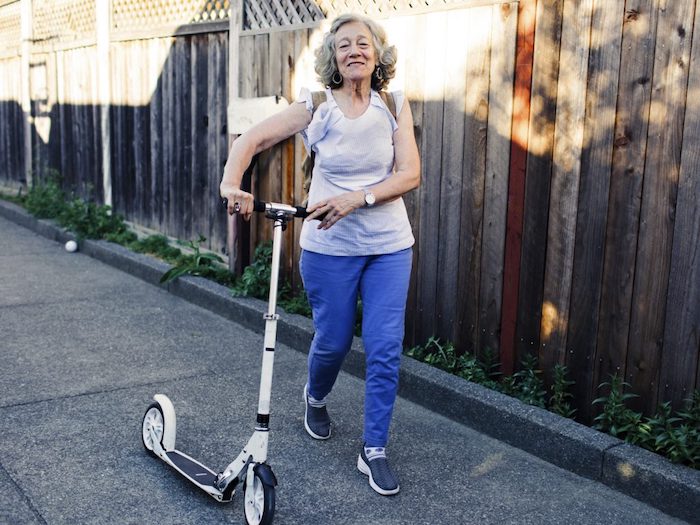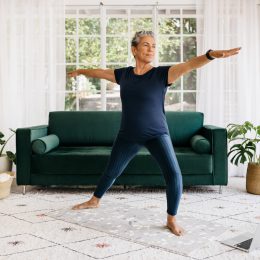Age Gracefully with This Subtle Mindset Shift
The first step to defy the rules of aging? Believe that you can. Here’s how.

When you think about getting older, how do you picture it?
The answer matters more than you think: Your attitude about aging, whether you think of it as a time of frailty and declineor as a time of growth and opportunity, partly determines how you will age. That’s why it pays to foster a growth mindset. And no, it’s not too late.
What Is Growth Mindset?
Growth mindset, which relates to self-image and self-esteem, is a belief that you can improve yourself through training, practice, or education, versus believing that your abilities are fixed and there’s not much you can do to improve them, explains Gary S. Moak, M.D., a geriatric psychiatrist and author of Beat Depression to Stay Healthier and Live Longer: A Guide for Older Adults and Their Families.
Mindset theory research shows that people who have a fixed mindset about their abilities tend to avoid challenges and show less resilience in the face of setbacks. They often interpret failure as a result of their own lack of ability.
Those with a growth mindset, on the other hand, tend to seek out challenging opportunities and see setbacks as teachable moments.
Emotional well-being and fitness go together! SilverSneakers classes and events are happening daily at participating gyms, online through SilverSneakers LIVE, and at community centers near you. Activate your free online account to get started.
How Growth Mindset Promotes Healthy Aging
A growing body of research is confirming that our thoughts about aging have real power. One study published in the journal Personality and Individual Differences found that loss of physical abilities in older adults was associated with cognitive decline—but only in those who held negative perceptions of aging.
Consider this real-life example from Dr. Moak: In his hometown in New Hampshire, it’s common for people to downhill ski well into their 80s, he says. He’s even known people who’ve continued to ski race into their 90s. One reason they can do this: They believe they can.
“If you approach late-middle age or early-old age with the view that aging inevitably comes with decline and frailty, it may become a self-fulfilling prophecy,” Dr. Moak says. “But if you go into aging recognizing that those things may happen but you can take steps to make a difference in what happens to you, you’ll not only maintain your abilities and functions, but you’ll also develop new ones.” That is growth mindset in a nutshell.
It sounds simple, but how exactly can you start to adjust your mentality for successful aging? Follow this four-step guide.
Step #1: Ignore Stereotypes
The number of antiaging products on the market make one thing very clear: We live in a youth-oriented society. Older individuals are often portrayed as being weak or feeble when that’s far from the truth, Dr. Moak says.
In fact, “studies show that levels of life satisfaction are highest among older adults compared to all other segments of the population,” he says. Once you understand that the stereotypes aren’t true, it can open your eyes to more possibilities and help nudge your mindset in the growth direction.
Step #2: Take Up Meditation, Yoga, or Other Mindfulness Practices
When you’re in touch with your thoughts and emotions in the present moment, it helps you feel grounded and in control. That’s why mindfulness practices, including yoga, meditation, or tai chi, are considered so good for mental health, Dr. Moak says.
“They help you develop greater self-confidence and a positive outlook on what you’re able to accomplish as you age,” he says.
Not sure where to start? Try this five-minute daily meditation. Or if you prefer active mindfulness techniques, this seven-minute yoga flow for older adults is a great option.
Recommended FREE SilverSneakers On-Demand Class: 5 Minute Moving Meditation
Step #3: Develop (or Maintain) an Exercise Habit
Among many other mind and body benefits, exercise can be incredibly empowering.
“With exercise, gains build on themselves,” Dr. Moak says. “Initially you may have some new aches and pains, but if you stick with it, you’ll notice you can do more than you could before, and then more than you ever thought possible.”
Seeing what you can do physically also has potential to transfer into other areas of your life, he says. You’ll gradually undo the negative bias that may be ingrained about aging. And before you know it, you may be learning pottery, a foreign language, or any other new skill.
If you haven’t been active recently, are recovering from an injury or illness, or are afraid you’ll get hurt when you exercise, talk to your doctor as a first step. Your doctor can give you guidelines for safe exercises that are specific to any health issues you may have. If you have an underlying issue or condition—for example, diabetes—your doctor can also help you get the right treatment.
Subscribe to our newsletter
It's quick and easy. You could be one of the 13 million people who are eligible.
Already a member? Click to discover our 15,000+ participating locations.
Follow Us
Another great way to start and maintain an exercise habit: Join a group fitness class. SilverSneakers members love our classes because they find support from instructors who are trained in working with older adults—and they love the camaraderie. Check your eligibility here.
SilverSneakers LIVE 15-minute Express classes are a great way to build a new exercise habit. View the schedule and RSVP here.
Step #4: Ask for Help If You Feel Depressed
“One of the assumptions we see many people make is that old age is depressing, and therefore depression is a normal coefficient of aging and just part of the deal,” Dr. Moak says. “So the problem is that a lot of people, based on those beliefs, go on living many years at a time with untreated depression.”
According to the National Institute on Aging, symptoms of depression include but are not limited to:
- Sad, anxious, or hopeless mood
- Loss of interest in things you once found pleasurable
- Decreased energy or fatigue
- Aches and pains without a clear physical cause
- Changes in appetite or sleep habits
It’s important to remember that feeling blue every now and then is totally normal. Even the most optimistic people in the world aren’t happy 24/7. But if you’ve been experiencing the symptoms above for more than two to four weeks, talk to your doctor so you can get the right diagnosis—and treatment.
Plus, learn more about the difference between sadness and depression.
See our sources:
Study on growth mindset and cognitive gain in older adults: The International Journal of Aging and Human Development
How negative perceptions of aging affect the brain: Personality and Individual Differences
Study on link between age and happiness: Journal of Clinical Psychiatry
Depression and older adults: National Institute on Aging
Check Your SilverSneakers Eligibility Instantly
SilverSneakers members can go to thousands of nationwide gyms and fitness locations, plus take SilverSneakers LIVE online classes that are designed for all fitness levels and abilities. If you have a Medicare Advantage plan, it may include SilverSneakers — at no additional cost. Check your eligibility instantly here.
Already a member? Get your SilverSneakers member ID and exclusive fitness and wellness content by activating your online account here.
Not eligible for SilverSneakers? You can still get 200+ free SilverSneakers On-Demand videos and stay in touch with us by creating your online account.





